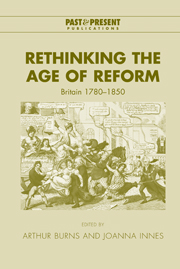Book contents
- Frontmatter
- Contents
- Notes on contributors
- Preface
- List of abbreviations
- 1 Introduction
- 2 ‘Reform’ in English public life: the fortunes of a word
- 3 Parliament, the state, and ‘Old Corruption’: conceptualizing reform, c. 1790–1832
- 4 ‘Old wine in new bottles’: the concept and practice of law reform, c. 1780–1830
- 5 English ‘church reform’ revisited, 1780–1840
- 6 Medicine in the age of reform
- 7 British antislavery reassessed
- 8 ‘The age of physiological reformers’: rethinking gender and domesticity in the age of reform
- 9 Reforming the aristocracy: opera and elite culture, 1780–1860
- 10 Reform on the London stage
- 11 Reforming culture: national art institutions in the age of reform
- 12 Irish reform between the 1798 Rebellion and the Great Famine
- 13 Empire and parliamentary reform: the 1832 Reform Act revisited
- 14 Reforms, movements for reform, and possibilities of reform: comparing Britain and continental Europe
- Index
- Past and Present Publications
10 - Reform on the London stage
Published online by Cambridge University Press: 15 December 2009
- Frontmatter
- Contents
- Notes on contributors
- Preface
- List of abbreviations
- 1 Introduction
- 2 ‘Reform’ in English public life: the fortunes of a word
- 3 Parliament, the state, and ‘Old Corruption’: conceptualizing reform, c. 1790–1832
- 4 ‘Old wine in new bottles’: the concept and practice of law reform, c. 1780–1830
- 5 English ‘church reform’ revisited, 1780–1840
- 6 Medicine in the age of reform
- 7 British antislavery reassessed
- 8 ‘The age of physiological reformers’: rethinking gender and domesticity in the age of reform
- 9 Reforming the aristocracy: opera and elite culture, 1780–1860
- 10 Reform on the London stage
- 11 Reforming culture: national art institutions in the age of reform
- 12 Irish reform between the 1798 Rebellion and the Great Famine
- 13 Empire and parliamentary reform: the 1832 Reform Act revisited
- 14 Reforms, movements for reform, and possibilities of reform: comparing Britain and continental Europe
- Index
- Past and Present Publications
Summary
In 1832, two movements for reform coincided. In June, the first Reform Act received royal assent, while in August, a select committee of the House of Commons reported the results of its inquiry into the current state of the British theatre. However, this coincidence was not accidental. Early nineteenth-century discussions of the theatre regarded it as an important cultural institution that represented particular views of the nation, while, conversely, political life in the first decades of the nineteenth century was conducted in an increasingly public and performative way. In this essay I will explore a variety of views of reform to be found in the London theatre industry in and around 1832, focusing on two contrasting concepts of a reformed theatre, one emerging from the select committee, and the other from performances at two of London's popular theatres, the Surrey and the Coburg. This contrast demonstrates the limits and boundaries of parliamentary attempts at reform of the theatres, and the existence of differing views about the desirable nature of a reformed theatre. In the hectic daily clamour of attractions, novelty, and spectacle in London's commercial theatre industry in the first third of the nineteenth century, discussions about reform of the theatre were not limited to its legislative regulation. They included tub-thumping about the ‘decline of the drama’ and the ‘national drama’, discussions of the constitution and respectability of audiences, and keenly promoted demonstrations of the quality of productions at the new theatres compared with the performances at the established Theatres Royal in Drury Lane and Covent Garden.
- Type
- Chapter
- Information
- Rethinking the Age of ReformBritain 1780–1850, pp. 238 - 253Publisher: Cambridge University PressPrint publication year: 2003
- 1
- Cited by



